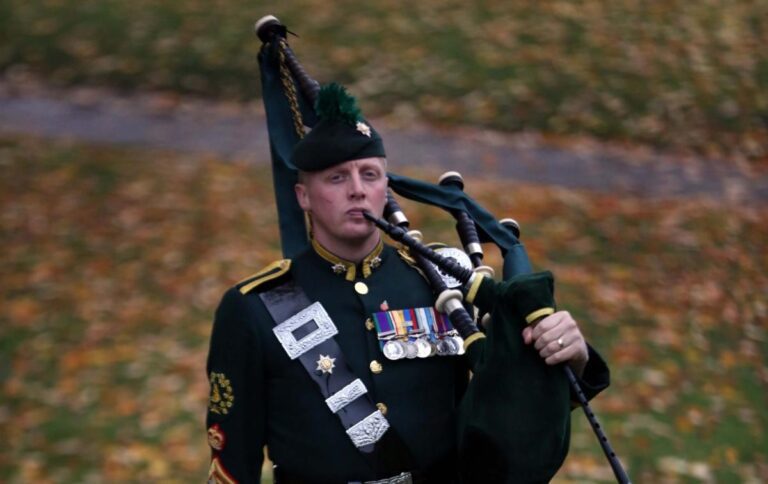
[ad_1]

He woke Queen Elizabeth II on her final morning, playing below her window at Balmoral as he had done every day.
Today, as the monarch’s body is slowly lowered from public view at St George’s Chapel, Pipe Major Paul Burns of The Royal Regiment of Scotland will play her out, the haunting sound of the piper’s lament signalling the time to say a final goodbye.
The nation will fall silent shortly before 12pm as the monarch is honoured by her children, grandchildren and a grateful nation.
Last Post will play at the Abbey before a two-minute silence is observed throughout the UK.
The King and members of the Royal family will be joined in that final moment of reflection by world leaders and people from all backgrounds, in all four UK nations and across the Commonwealth. Those to whom the Queen devoted her life.
Together, they will pay silent tribute to that historic reign.
Reveille will then sound, followed by the National Anthem before the Queen’s piper plays a lament, bringing the funeral service to an end.
The bearer party will then lift the coffin from the catafalque before moving in procession through the Great West Door, returning to the state gun carriage.
Following behind, will be the King and Queen Consort, the Prince and Princess of Wales and members of the Royal family who will walk in a procession to Wellington Arch.
Later, as the committal service at St George’s Chapel, Windsor, attended by family members and Royal household staff past and present, draws to a close, the sovereign’s piper will herald the moment so many have dreaded.
As the Queen’s coffin is slowly lowered, he will play a lament from the doorway between the chapel and the Dean’s Cloister.
As he does so, he will walk slowly towards the Deanery in the Cloister so the music inside the chapel gradually fades.
The symbolism of the moment, echoing a similar end to the Duke of Edinburgh’s funeral last April, will be lost on no one.
As the music peters out and the coffin lowers, so too the Queen takes her leave, bidding the nation goodbye.
The Queen’s piper played for 15 minutes underneath her window at 9am every morning, whether she was at Balmoral, Windsor Castle, Buckingham Palace or Holyroodhouse.

The position is deemed one of the highest accolades available to a piper serving in the Armed Forces. He is the only non-royal permitted to wear Balmoral tartan.
The post dates back to the time of Queen Victoria, who first heard bagpipe music in 1842 when she and Prince Albert visited the Highlands for the first time.
They were staying at Taymouth Castle with the Marquess of Breadalbane, who had his own personal piper, and she was quite taken with the idea.
She wrote to her mother: “We have heard nothing but bagpipes since we have been in the beautiful Highlands and I have become so fond of it that I mean to have a piper, who can if you like it, pipe every night at Frogmore.”
After Queen Victoria’s death, successive monarchs retained the piper’s services.
Pipe Major Scott Methven, the former royal piper who served the Queen from 2015 until 2019, this week recalled her “quick wit” and kindness.
Last year, he revealed that the monarch had “pulled it out of the bag” for him when his wife was diagnosed with terminal cancer in 2017.
As well as ensuring their two children were cared for at Balmoral by royal nannies she was taken to hospital, the Queen also had a basket of strawberries and muffins sent to her nurses
“Her Majesty supported me with everything that went on in my private life,” Methven said.
[ad_2]